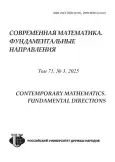Continuous generation population model with discontinuous life cycle characteristics
- Authors: Perevaryukha A.Y.1
-
Affiliations:
- Saint Petersburg Institute for Informatics and Automation of the RAS
- Issue: Vol 71, No 3 (2025): Proceedings of the Crimean Autumn Mathematical School-Symposium
- Pages: 443-451
- Section: Articles
- URL: https://journal-vniispk.ru/2413-3639/article/view/347346
- DOI: https://doi.org/10.22363/2413-3639-2025-71-3-443-451
- EDN: https://elibrary.ru/FMBVJU
- ID: 347346
Cite item
Full Text
Abstract
Traditionally, continuous models of mathematical biology are focused on the dynamics of interacting populations as stationary homogeneous entities. The state of the populations in the equations is governed by factors common to all individuals \( \forall t,N(t) \): reproductive efficiency, mortality, living space limitations, or resource limitations. Many species exist with nonoverlapping generation sequences, replacing each other under different seasonal conditions. The number of annual generations is an important characteristic of the ecology of a species when occupying a new range. The length of the life cycle and the index of reproductive activity r in adjacent generations of insects in a range vary due to the need for wintering. Fluctuations in these values affect rapid population outbreaks. It is shown that the use of discrete models \( x_{n+1}=\psi(x_n;r)\varphi(x_{n-i})-\Xi \) is unrealistic for fundamental reasons. The appearance of cycles \( p\neq2^i \) in the order of Sharkovsky's theorem is excessive for the analysis of populations and the forecast of mass reproductions of insects. The article proposes a method for organizing models of the conjugate development of a succession of generations in a system of discontinuous differential equations as a sequence of boundary-value problems. The model is event-based redefined to obtain a solution on time intervals corresponding to the conditions of the season. The model taking into account competition and delayed regulation is relevant for the analysis of a sequence of peaks in pest activity, which are characterized by individual extremely numerous generations.
About the authors
A. Yu. Perevaryukha
Saint Petersburg Institute for Informatics and Automation of the RAS
Author for correspondence.
Email: madelf@rambler.ru
Saint Petersburg, Russia
References
- Abbas S., Niezabitowski M., Grace S. Global existence and stability of Nicholson blowflies model with harvesting and random effect// Nonlinear Dyn. - 2021. - 103. - С. 2109-2123.
- Andreassen H. Population cycles and outbreaks of small rodents: ten essential questions we still need to solve// Oecologia - 2021. - 195. - С. 601-622.
- Borisova T. Yu. On the physicochemical method of analysis of the formation of secondary immunodeficiency as a bioindicator of the state of ecosystems using the example of seabed biota of the Caspian Sea// Techn. Phys. Lett. - 2022. - 48. - С. 251-257.
- Brillinger D. The Nicholson blowfly experiments// J. Time Ser. Anal. - 2012. - 33. - С. 718-723.
- Feigenbaum M. Universal behavior in nonlinear systems// Los Alamos Sci. - 1980. - 1. - С. 4-27.
- Foerster H., Mora P. M., Amiot L. Doomsday: Friday, 13 November, A.D. 2026// Science. - 1960. - 132, № 3436. - С. 1291-1295.
- Hoang M. A generalized model for the population dynamics of a two stage species with recruitment and capture using a nonstandard finite difference scheme// Comp. Appl. Math. - 2024. - 43. - С. 47-57.
- Kloeden P. On Sharkovsky’s cycle coexistence ordering// Bulle. Austral. Math. Soc. - 1979. - 20. - С. 171- 178.
- Lee H., York J. Period three implies chaos// Am. Math. Monthly. - 1975. - 82. - С. 985-992.
- Mikhailov V. V. Computational modeling of the nonlinear metabolism rate as a trigger mechanism of extreme dynamics of invasion processes// Techn. Phys. Lett. - 2022. - 48. - С. 301-304.
- Perevaryukha A. Y. Modeling of a crisis in the biophysical process by the method of predicative hybrid structures// Techn. Phys. - 2022. - 67, № 6. - С. 523-532.
- Sharkovski A. N. Co-existence of cycles of a continuous map of the line into itself// Internat. J. Bifur. Chaos Appl. Sci. Engrg. - 1995. - 5. - С. 1263-1273.
- Shorrocks B. Population fluctuations in the fruit fly (drosophila melanogaster) maintained in the laboratory// J. Animal Ecol. - 1970. - 39. - С. 229-253.
- Singer D. Stable orbits and bifurcations of the maps on the interval// SIAM J. Appl. Math. - 1978. - 35. - С. 260-268.
- Trofimova I. V. Adequacy of interpretation of monitoring data on biophysical processes in terms of the theory of bifurcations and chaotic dynamics// Techn. Phys. Lett. - 2022. - 48. - С. 305-310.
Supplementary files









